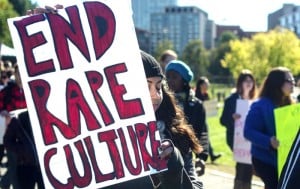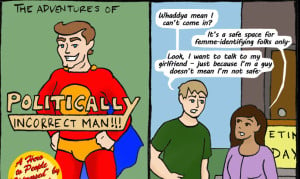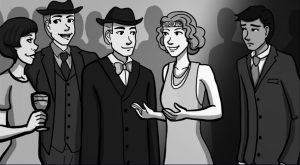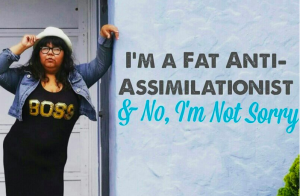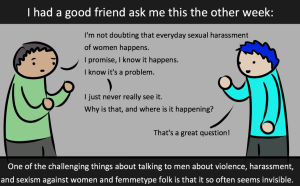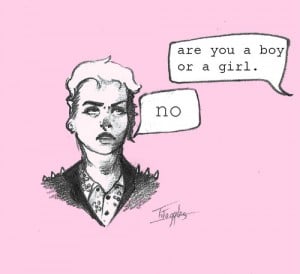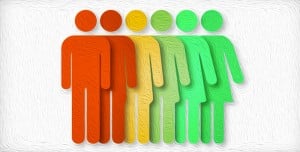
Source: Huffington Post
What is sexism?
This might seem like a pretty basic question to ask in an article on a feminist site, but I’ve recently noticed that very few people actually understand what sexism is.
It’s incredibly important that we know what sexism is — because that’s our first step to recognizing and challenging it whenever we can.
Often, I see people conflating sexism with gender-based prejudice. Although the two are related, they’re not entirely the same thing.
It’s totally understandable why many people conflate the two. The mainstream media does it. The education system often does it. Even dictionaries do it.
The Oxford Dictionary defines sexism as “prejudice, stereotyping, or discrimination, typically against women, on the basis of sex.”
But the reality is that sexism is so much bigger than prejudice, stereotyping, and discrimination.
We need to reject this simplified definition of sexism and recognize the difference between sexism and gender-based prejudice.
It’s important to remember that dictionary definitions aren’t always adequate, and that they can be challenged. The dictionary can also give me a definition of the word “life,” but it can’t tell me the meaning of life.
The dictionary tells me that a theory is “an idea or set of ideas that is intended to explain facts or events,” but in science, the word means something else.
It’s incredibly important that we unlearn this one-dimensional, oversimplified definition of sexism and start understanding sexism as a broader system of oppression.
A note on the language: In this article, I use the term “non-men” to refer to those who are directly oppressed by sexism. I do this because I think it’s important to acknowledge that women aren’t the only people who suffer from gender-based oppression.
Non-binary people – i.e. people that do not identify as either a man or a woman – are also oppressed by sexism. To uphold the idea that women are the only victims of sexism is to erase non-binary people.
This is not to say that men aren’t affected by sexism at all. Trans men and gender non-conforming men are particularly affected by sexism. This is because sexism doesn’t exist in isolation: It interacts with a number of different forms of oppression in one overarching kyriarchy.
Because of kyriarchy, certain men – particularly cisgender, white, heterosexual, able-bodied, middle-class men – benefit from male privilege more than others.
But this doesn’t mean that marginalized men don’t hold male privilege at all – just that they face other kinds of oppression, too.
That being said, whether someone experiences male privilege or not often depends on what their gender is perceived to be. Some men – particularly trans men – might not ‘pass’ as male, meaning that many people assume them to be women and therefore treat them as such. In this case, they can experience very little – if any – male privilege.
Let’s get right into this.
Here are three key ways in which sexism and gender-based prejudice differ.
1. Sexism Is Systemic
The first important thing to understand about sexism is that it is systemic. Gender-based prejudice, on the other hand, is individual, although it exists in the context of a sexist system.
When I say systemic, I mean that a number of different factors interact and result in the oppression of people perceived to be non-men.
Sexism doesn’t exist in isolation: It is ingrained into institutions like the education system, religious bodies, the legal system, the media, governments, corporations, and even NGOs and charity organizations.
These institutions have power, and often – intentionally or not – they uphold male privilege while oppressing those who aren’t men.
Let’s use an example to illustrate this idea: A woman married a man who is abusive.
She didn’t want to have children because of her circumstances, but because of cissexist, misogynistic laws and social dynamics she doesn’t have access to adequate contraception and abortion.
She ends up having two children. She wants to leave her husband, but she’s unable to do so for a number of reasons.
If she were to leave her husband, she would struggle financially. She’s unlikely to be hired because she has small children, and companies are often prejudiced towards mothers of young children as they believe women would rather concentrate on home-making than on their work.
She didn’t receive any tertiary education because she was socialized to believe that women should focus on being wives and mothers, rather than on education.
Even if she were able to secure a job, women are statistically likely to earn less than men for doing the same work, and she’ll never be able to earn as much as what her husband earns.
Additionally, she’s more likely to be sexually harassed at work, and if she spoke out about it, she might lose her job and be unable to support her children.
On top of this, her church condemns divorce even when one’s spouse is abusive, and she risks losing the support of her religious community if she were to leave her husband.
Her circumstances did not arise because of one person’s prejudice. She is trapped in a difficult, dangerous situation because a number of different systems interacted to oppress her.
The thing about oppression is that it traps you. You can move away from a single, bigoted person who is making sexist comments, but you can’t get away from a set of systems that governs every aspect of your life.
And of course, in that example, I only mentioned examples of gender-based oppression. Other forms of oppression might intersect with sexism, making her situation even more difficult.
Let’s say she’s black. She’s likely to earn even less than a white woman. Let’s say she’s bisexual and she tries to visit a therapist, who is prejudiced towards her because of her sexual orientation, and therefore therapy is more harmful than helpful.
Perhaps she’s fat, and when she visits her doctor after being physically assaulted by her husband, her doctor fat-shames her. This results in her avoiding getting medical attention altogether.
These other forms of oppression work along with sexism, making her situation even worse.
Let’s take a look at how men might be affected by gender-based discrimination. Let’s imagine the situation of a man who is physically abused by his wife.
Because of gender-based stereotypes, the abuse of men by women is often turned into a joke or ignored by most of society.
Not only is that a serious problem, but it’s also one that feminists are working actively to dismantle.
But unlike the woman in the previous example, he is less likely to struggle as much financially if he were to leave his abusive partner.
He’s less likely to face gender-based discrimination when applying for jobs.
As the single father of young children, he’s less likely to be discriminated against and demonized than a single mother.
This doesn’t mean his experiences weren’t painful or difficult. It doesn’t mean that we shouldn’t care about men who experience domestic violence.
It’s to say that his male privilege makes his situation easier to that of non-men in the same situation. Male privilege makes it a little more possible to leave his situation.
As you can see, sexism is a broad system. When we conflate sexism with gender-based prejudice, we ignore and erase the ways in which institutions work together to trap and oppress non-men.
2. Sexism Doesn’t Require Intention
If we look at sexism as a system, we can use the word “sexist” to describe actions that reflect and perpetuate this system.
We can perpetuate sexism without consistently or consciously holding sexist prejudice.
Let’s use a really simple example to illustrate this idea.
My friend once shared a meme that sexualized a female sports star and implied that her achievements didn’t matter because she was hot.
When we called my friend in on this, he said it’s not sexist because – being bisexual – he would have shared the exact same meme if it were about an attractive male sports star.
He argued that his actions weren’t sexist because they could have applied to men and women. But here’s the thing: His actions didn’t exist in a vacuum.
They existed in the context of a society that devalues and underpays female athletes, discourages women from playing sports, and asserts that a woman’s value depends entirely on her physical appearance.
The meme therefore perpetuated and reflected sexism.
If the meme was about a male athlete, it would not have been nearly as harmful, because it exists in a society where male athletes are highly valued and encouraged to participate in sports.
So, while my friend might not have held a conscious prejudice against female athletes, his actions were ultimately harmful.
That meme most likely reinforced others’ prejudiced thinking while hurting and discouraging female athletes.
Contributing to its virality – even in a small way – propagates sexism.
Often, people believe that their actions aren’t harmful because they didn’t intend for them to be harmful. This leads to people getting hurt and becoming defensive if we call their actions harmful.
If we understand sexism as a system and not simply an individual prejudice, we’ll begin to understand that intention is not as important as impact.
We can hurt someone whether we intend to or not. We can oppress someone whether we are consciously prejudiced towards them or not.
Sexism doesn’t require our intentional discriminatory attitudes to thrive – we can cultivate a sexist society without consciously intending to.
This is why we need to constantly be conscious of our actions and the way they could further entrench sexism.
3. Gender-Based Prejudice Can Target People of Any Gender (But Sexism Goes One Way)
I could hold some prejudiced opinions about men.
I could believe that men shouldn’t cry. I could believe that men should be sporty and physical. I could believe that men always have to be the breadwinners.
But men would still not experience gender-based oppression. I could have gender-based prejudices against men, but I can’t oppress men on the basis of their gender.
Regardless of my opinion, men will still earn more on average than non-men. Non-men are still more likely to suffer from sexual and gender-based violence. Male supremacy will still exist.
This is not to say that it’s okay to hold gender-based prejudices about men. Perpetuating stereotypes about any gender can be extremely harmful.
If we hold the belief that there is one “right” way to perform gender, we are policing the way people behave, and that is not okay. This can be particularly damaging to people who don’t conform to gender stereotypes.
But men who experience oppression based on the way they express their gender are still not oppressed on the basis of their gender itself.
That is to say, they’re not experiencing that oppression because they’re men.
Non-men, on the other hand, experience gender-based oppression because they aren’t men.
***
We need to challenge the oversimplified, mainstream definitions of sexism. It is imperative that we think critically about what oppression truly is, how it manifests, and what it looks like.
After all, we can’t effectively fight sexism if we’re not sure what it is.
[do_widget id=”text-101″]
Sian Ferguson is a Contributing Writer at Everyday Feminism. She is a South African feminist currently studying towards a Bachelors of Social Science degree majoring in English Language and Literature and Gender Studies at the University of Cape Town. She has been featured as a guest writer on websites such as Women24 and Foxy Box, while also writing for her personal blog. In her spare time, she tweets excessively @sianfergs, reads about current affairs, and spends time with her gorgeous group of friends. Read her articles here.
Search our 3000+ articles!
Read our articles about:
Our online racial justice training
Used by hundreds of universities, non-profits, and businesses.
Click to learn more





